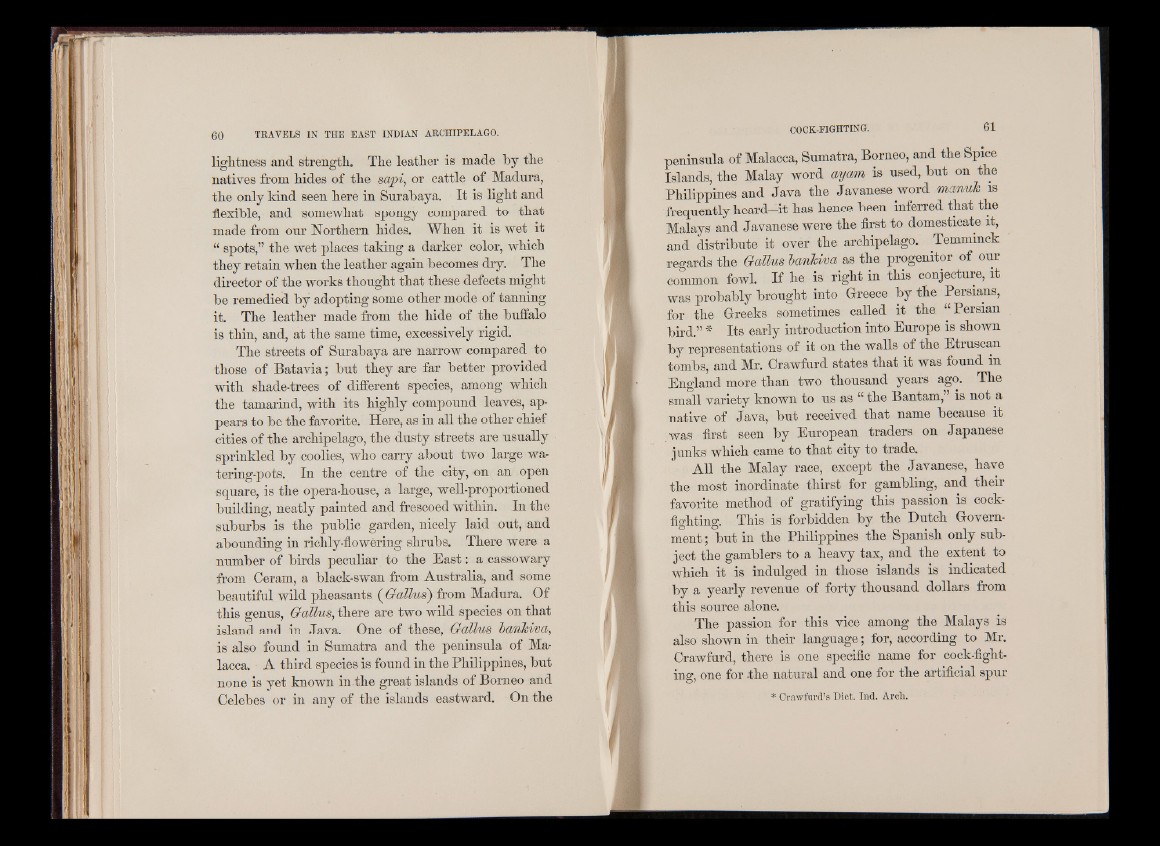
lightness and strength. The leather is made by the
natives from hides of the sapi, or cattle of Madura,
the only kind seen here in Surabaya. It is light and
flexible, and somewhat spongy compared to that
made from our Northern hides. When it is wet it
“ spots,” the wet places taking a darker color, which
they retain when the leather again becomes dry. The
director of the works thought that these defects might
be remedied by adopting some other mode of tanning
it. The leather made from the hide of the buffalo
is thin, and, at the same time, excessively rigid.
The streets of Surabaya are narrow compared to
those of Batavia; but they are far better provided
with shade-trees of different species, among which
the tamarind, with its highly compound leaves, appears
to be the favorite. Here, as in all the other chief
cities of the archipelago, the dusty streets are usually
sprinkled by coolies, who carry about two large watering
pots. In the centre of the city, on an open
•square, is the opera-house, a large, well-proportioned
building, neatly painted and frescoed within. In the
suburbs is the public garden, nicely laid out, and
abounding in richly-flowering shrubs. There were a
number of birds peculiar to the E a s t: a cassowary
from Ceram, a black-swan from Australia, and some
beautiful wild pheasants ( Gall/us) from Madura. Of
this genus, Gaikos, there are two wild species on that
island and in Java. One of these, Gaikos bamlciva,
is also found in Sumatra and the peninsula of Malacca.
A third species is found in the Philippines, but
none is yet known in.the great islands of Borneo and
Celebes or in any of the islands eastward. On the
peninsula of Malacca, Sumatra, Borneo, and the Spice
Islands, the Malay word ay am is used, but on the
Philippines and Java the Javanese word manuk is
frequently heard—it has hence been inferred that the
Malays and Javanese were the first to domesticate it,
and distribute it over the archipelago. Temminck
regards the Gallus bankiva as the progenitor of our
common fowl. If he is right in this conjecture, it
was probably brought into Greece by the Persians,
for the Greeks sometimes called it the “ Persian
bird.” * Its early introduction into Europe is shown
by representations of it on the walls of the Etruscan
tombs, and Mr. Crawfurd states that it was found in
England more than two thousand years ago. The
small variety known to us as “ the Bantam, is not a
native of Java, but received that name because it
was first seen by European traders on Japanese
junks which came to that city to trade.
All the Malay race, except the Javanese, have
the most inordinate thirst for gambling, and their
favorite method of gratifying this passion is cock-
fighting. This is forbidden by the Dutch Government
; but in the Philippines the Spanish only subject
the gamblers to a heavy tax, and the extent to
which it is indulged in those islands is indicated
by a yearly revenue of forty thousand dollars from
this source alone.
The passion for this vice among the Malays is
also shown in their language; for, according to Mr.
Crawfurd, there is one specific name for cock-fighting,
one for .the natural and one for the artificial spur
* Crawfurd’s Diet. Ind. Arch.